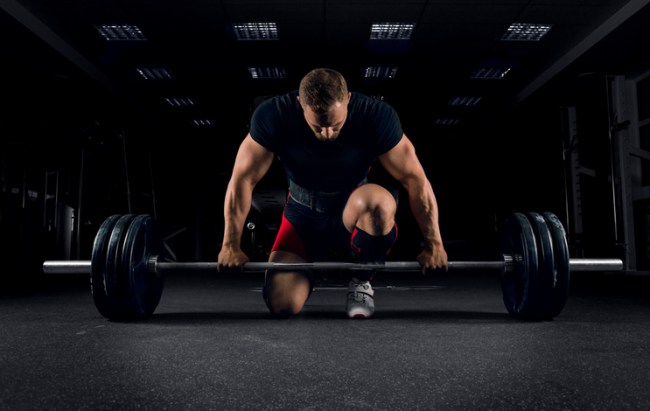
iStockphoto
I know exactly what you’re thinking: ‘The deadlift is the easiest lift ever. You just pick the weight up off the ground, and boom – job done.’ Whilst that’s a decent creed for anyone training for a crappy deadlift, there’s a whole lot more to a killer deadlift than just brute force.
Technique is incredibly important, and to master the deadlift, you’re going to have to exercise a muscle you’ve probably been neglecting: your brain.
Warm Up
In the gym, there are 3 measures of manliness – how big you are, how much you can lift, and how little warming up you do. Somehow, warming up has become a serious gym taboo, as frowned upon as walking into a locker room and offering to oil up other gym members.
If you want a solid deadlift, you need to ditch this belief. Warming up reduces your risk of injury and allows you to practice your technique, improving your performance in the long run. To get started, try a simple deadlift warmup like this:
2×5, 40%
[of working set weight]
1×5, 55%
1×5, 70%
1×5, 85%
1×5, 100%
[working set]
Experiment with Sumo vs. Traditional
As I said in the intro, there’s more to the humble deadlift than meets the eye. In order to be the strongest you can possibly be, it’s crucial that you choose the right style of the deadlift – either traditional or sumo.
Traditional Deadlift
The most common type of deadlift, typically performed with a narrow foot placement, and your hands placed outside of your feet.
Sumo Deadlift
A variation with a super-wide foot placement, and your hands placed inside of your feet.
Each and every bro has a unique body, with its own set of mechanics – and each of us will respond differently to each style of deadlift. The traditional deadlift is best for people with long arms and legs, relative to their torso. It allows them to make the most out of their long limbs, and create as much explosive power in the initial off-the-ground drive. In contrast, the sumo is better for those people with shorter limbs, and longer torsos – minimizing the distance the bar has to travel.
Assistance Exercises
Unless you’re looking to qualify for wheelchair bodybuilding competitions, we can’t deadlift every day. Thankfully, these assistance exercises will improve your deadlift without causing any overtraining.
· Heavy Goddamn Squatting
Whilst squats aren’t the same as deadlifting, they’re still an incredible exercise for building up your strength in the posterior chain. And let’s face it – you need all the leg sessions you can get.
· Leg Press
If your back is suffering from heavy deadlifts and squats, turn to the leg press. It takes your back out of the equation, and allows you to isolate your hamstrings, quads and glutes.
· Partial Deadlifts
If your lockout sucks, practice with partial deadlifts. Set a squat rack’s safety bars to a few inches below your lockout height, and practice the top portion of the movement with some serious poundage.
· Barbell Shrugs
Whilst you’re at it, barbell shrugs are another invaluable tool for improving lockout and grip strength. Chalk your hands, use an overhand grip and practice low-rep sets with some decent weight.
Low-Rep Training
If you’ve ever done a 15-rep pull, you’ll know that high-rep deadlifts are a seriously bad idea. It’s a hard exercise at the best of times, and anything more than 5-6 reps can cause your form to turn to crap.
Low-rep training keeps your form tight, maximizes the working load on your muscles, and makes you feel good. This isn’t crossfit bro, we’re not doing power exercises for reps of 50.
Train with Chuck Taylor
There’s a proven correlation between exposed skin and bodybuilding success, in my mind. When it comes to the deadlift, there’s also a solid reason for removing your shoes. Thick-soled shoes make it harder to lift, increasing the distance the bar has to travel and reducing your stability. Deadlift in bare feet, or at the very least, find yourself a pair of Chuck Taylor’s.
Deadlift More
There’s an old gym adage that says ‘to deadlift more, you have to deadlift more.’ There’s simply no substitute for practice, and to master the deadlift, you have to put the hours in. Train consistently, train heavy, train safely, and remember:
If the bar ain’t bending, you’re just pretending.